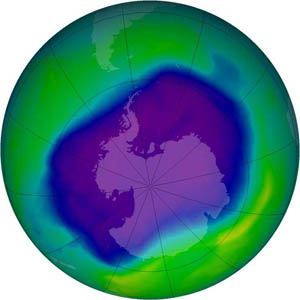Antarctic ozone hole remains stable for 2014
 Washington, Oct 31 - The scientists from NASA and the National Oceanic and Atmospheric Administration (NOAA) have recently reported that the Antarctic ozone hole reached its annual peak size on Sept. 11, 2014, which was almost similar to that in 2013.
Washington, Oct 31 - The scientists from NASA and the National Oceanic and Atmospheric Administration (NOAA) have recently reported that the Antarctic ozone hole reached its annual peak size on Sept. 11, 2014, which was almost similar to that in 2013.
The size of this year's hole was 24.1 million square kilometers, an area roughly the size of North America .
The single-day maximum area was similar to that in 2013, which reached 24.0 million square kilometers (9.3 million square miles). The largest single-day ozone hole ever recorded by satellite was 29.9 million square kilometers (11.5 million square miles) on Sept. 9, 2000.
Overall, the 2014 ozone hole was smaller than the large holes of the 1998-2006 periods, and was comparable to 2010, 2012, and 2013.
With the increased atmospheric chlorine levels present since the 1980s, the Antarctic ozone hole forms and expands during the Southern Hemisphere spring (August and September).
The ozone layer helps shield life on Earth from potentially harmful ultraviolet radiation that can cause skin cancer and damage plants.
Scientists also found that the minimum thickness of ozone layer this year was recorded at 114 Dobson units on Sept. 30, compared to 250-350 Dobson units during the 1960s.
Over the last 50 years satellite and ground-based records over Antarctica show ozone column amounts ranging from 100 to 400 Dobson units, which translates to about 1 millimeter to 5 millimeters of ozone in a layer if all of the ozone were brought down to the surface.
Scientists are working to determine if the ozone hole trend over the last decade was a result of temperature increases or chorine declines. (ANI)